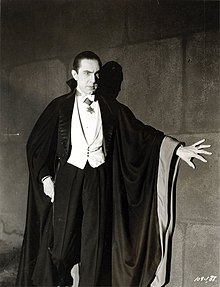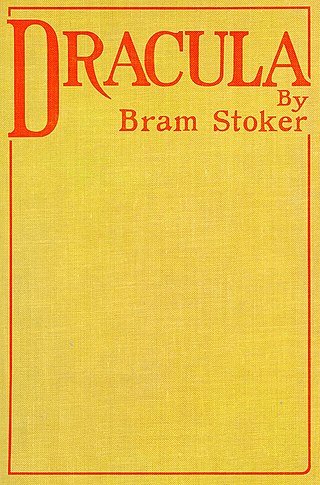
Dracula is a novel by Bram Stoker, published in 1897. An epistolary novel, the narrative is related through letters, diary entries, and newspaper articles. It has no single protagonist and opens with solicitor Jonathan Harker taking a business trip to stay at the castle of a Transylvanian nobleman, Count Dracula. Harker escapes the castle after discovering that Dracula is a vampire, and the Count moves to England and plagues the seaside town of Whitby. A small group, led by Abraham Van Helsing, investigate, hunt and kill Dracula.

Bram Stoker's Dracula is a 1992 American horror film directed and produced by Francis Ford Coppola, based on the 1897 novel Dracula by Bram Stoker. It stars Gary Oldman as Count Dracula, Winona Ryder as Mina Harker, Anthony Hopkins as Professor Abraham Van Helsing, and Keanu Reeves as Jonathan Harker.
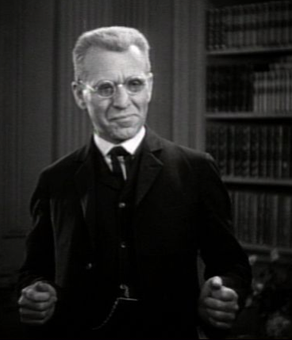
Professor Abraham Van Helsing, a fictional character from the 1897 gothic horror novel Dracula written by Bram Stoker. Van Helsing is a Dutch polymath doctor with a wide range of interests and accomplishments, partly attested by the string of letters that follows his name: "MD, D.Ph., D.Litt., etc.", indicating a wealth of experience, education and expertise. He is a doctor, professor, lawyer, philosopher, scientist and metaphysic. The character is best known through many adaptations of the story as a vampire slayer, monster hunter and the arch-nemesis of Count Dracula, and the prototypical and the archetypical parapsychologist in subsequent works of paranormal fiction.

R. M. Renfield is a fictional character who appears in Bram Stoker's 1897 Gothic horror novel Dracula. He is Count Dracula's deranged, fanatically devoted servant and familiar, helping him in his plan to turn Mina Harker into a vampire in return for a continuous supply of insects to consume and the promise of immortality. Throughout the novel, he resides in an asylum, where he is treated by Dr. John Seward.

Count Orlok, commonly but erroneously known as Nosferatu, is the main antagonist and title character portrayed by German actor Max Schreck (1879–1936) in the silent film Nosferatu, eine Symphonie des Grauens (1922). He was based on Bram Stoker's character Count Dracula.
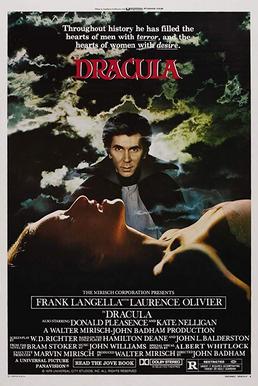
Dracula is a 1979 American gothic horror film directed by John Badham. The film starred Frank Langella in the title role as well as Laurence Olivier, Donald Pleasence and Kate Nelligan.

Wilhelmina "Mina" Harker is a fictional character and the main female character in Bram Stoker's 1897 Gothic horror novel Dracula.

Quincey P. Morris is a fictional character in Bram Stoker's 1897 gothic novel Dracula.

Vampire films have been a staple in world cinema since the era of silent films, so much so that the depiction of vampires in popular culture is strongly based upon their depiction in films throughout the years. The most popular cinematic adaptation of vampire fiction has been from Bram Stoker's 1897 novel Dracula, with over 170 versions to date. Running a distant second are adaptations of the 1872 novel Carmilla by Sheridan Le Fanu. By 2005, the Dracula character had been the subject of more films than any other fictional character except Sherlock Holmes.

The Brides of Dracula are fictional characters in Bram Stoker's 1897 novel Dracula. They are three seductive vampire "sisters" who reside with Count Dracula in his castle in Transylvania, where they entice men with their beauty and charm, and then proceed to feed upon them. Dracula provides them with victims to devour, mainly implied to be infants.

Jonathan Harker is a fictional character and one of the main protagonists of Bram Stoker's 1897 Gothic horror novel Dracula. An English solicitor, his journey to Transylvania and encounter with the vampire Count Dracula and his Brides at Castle Dracula constitutes the dramatic opening scenes in the novel and most of the film adaptations.
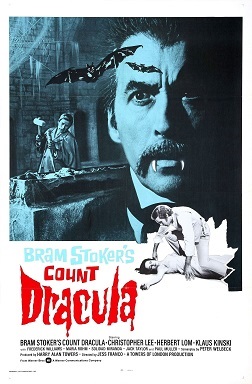
Count Dracula is a 1970 gothic horror film directed by Jesús Franco, based on the novel Dracula by Bram Stoker. It stars Christopher Lee, Herbert Lom and Klaus Kinski.

Count Dracula is a British television adaptation of the 1897 novel Dracula by Bram Stoker. Produced by the BBC, it first aired on BBC 2 on 22 December 1977. It is among the more faithful of the many adaptations of the original book. Directed by Philip Saville from a screenplay by Gerald Savory, it stars Louis Jourdan as Count Dracula and Frank Finlay as Professor Van Helsing.
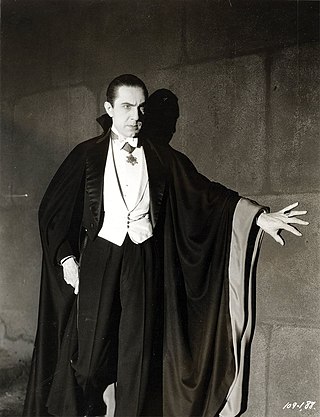
Count Dracula is the title character of Bram Stoker's 1897 gothic horror novel Dracula. He is considered the prototypical and archetypal vampire in subsequent works of fiction. Aspects of the character are believed by some to have been inspired by the 15th-century Wallachian prince Vlad the Impaler, who was also known as Vlad Dracula, and by Sir Henry Irving, an actor for whom Stoker was a personal assistant.

Dracula, also known as Bram Stoker's Dracula and Dan Curtis' Dracula, is a 1974 British made-for-television gothic horror film and adaptation of Bram Stoker's 1897 novel Dracula. It was written by Richard Matheson and directed by Dark Shadows creator Dan Curtis, with Jack Palance in the title role. It was the second collaboration for Curtis and Palance after the 1968 TV film The Strange Case of Dr. Jekyll and Mr. Hyde.
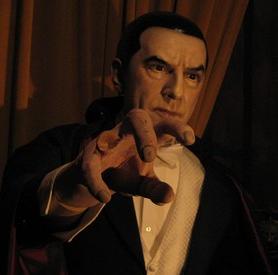
The character of Count Dracula from the 1897 novel Dracula by Bram Stoker, has remained popular over the years, and many forms of media have adopted the character in various forms. In their book Dracula in Visual Media, authors John Edgar Browning and Caroline Joan S. Picart declared that no other horror character or vampire has been emulated more times than Count Dracula. Most variations of Dracula across film, comics, television and documentaries predominantly explore the character of Dracula as he was first portrayed in film, with only a few adapting Stoker's original narrative more closely. These including borrowing the look of Count Dracula in both the Universal's series of Dracula and Hammer's series of Dracula, including include the characters clothing, mannerisms, physical features hair style and his motivations such as wanting to be in a home away from Europe.
Elizabeth Russell Miller was a Professor Emerita at Memorial University of Newfoundland. She resided in Toronto. In her early academic career, she focused on Newfoundland literature, primarily the life and work of her father, well-known Newfoundland author and humorist Ted Russell. Beginning in 1990, her major field of research was Bram Stoker's novel Dracula, its author, sources and influence. She published several books on the subject, including Reflections on Dracula, Dracula: Sense & Nonsense, a volume on Dracula for the Dictionary of Literary Biography and, most recently, Bram Stoker's Notes for Dracula: A Facsimile Edition with Robert Eighteen-Bisang. She founded the Dracula Research Centre and was the founding editor of the Journal of Dracula Studies now at Kutztown University of Pennsylvania.
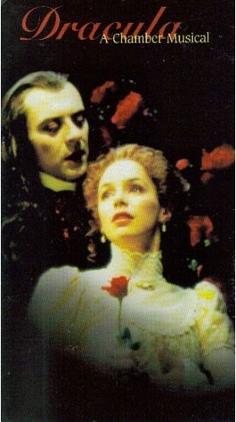
Dracula: A Chamber Musical is a 1997 Canadian musical adaptation of Bram Stoker's 1897 novel Dracula. The book and lyrics are by Richard Ouzounian and the music and orchestration are by Marek Norman. After premiering at the Neptune Theatre in Halifax, Nova Scotia, in 1997, Dracula in 1999 became the first Canadian musical to be staged at the Stratford Shakespeare Festival.

Dracula the Un-dead is a 2009 sequel to Bram Stoker's classic 1897 novel Dracula. The book was written by Bram Stoker's great-grandnephew Dacre Stoker and Ian Holt. Previously, Holt had been a direct-to-DVD horror screenwriter, and Stoker a track and field coach.

Castle Dracula is the fictitious Transylvanian residence of Count Dracula, the vampire antagonist in Bram Stoker's 1897 horror novel Dracula. The first few scenes and last few such as where he dies also take place here.
